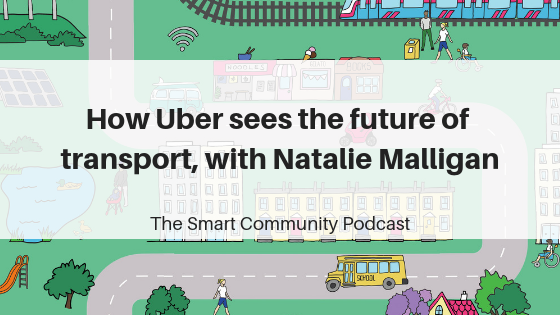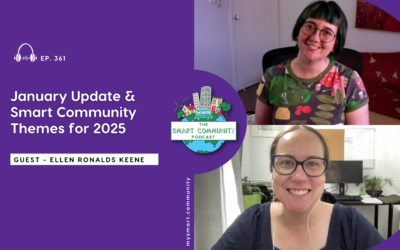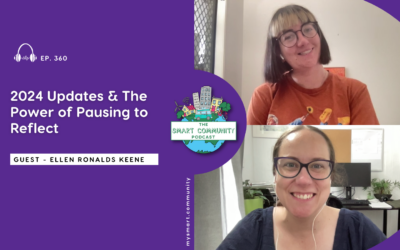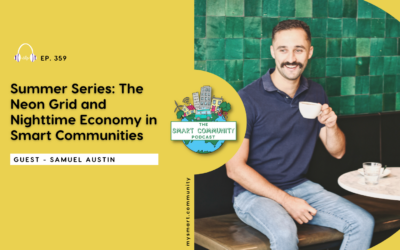In this bonus #mobilitymarch episode of the Smart Community Podcast, Zoe has a fascinating chat with Natalie Malligan, the Head of Cities for Australia and New Zealand at Uber. This is a short but jam packed episode, and it’s also a perfect follow up to our previous episode featuring Sampo Hietanen, all about Mobility as a Service, so if you haven’t listened to that episode yet, I’d recommend you go back and listen to it before this one, as Zoe and Natalie do talk about MaaS a bit here so Sampo’s episode will be useful for a bit more context in that regard. In this episode, Natalie shares a bit about how Uber sees the future of transport and some of their projects worldwide, including taking part in the Transport NSW Mobility as a Service Challenge, and integrating the public transport services into the Uber App in the City of Denver in the US. Zoe and Natalie discuss how Australian consumers and governments are embracing Smart concepts, and how this has changed over time, as well as why Uber has been so successful in become a household name. Natalie explains how Uber views their role in the transport sector, and some of their other projects like up-coming on-demand aircraft service Uber Elevate and the open data platform Movement. Natalie and Zoe finish their conversation on how Uber has changed their approach over the years, and the emerging trends of micro-mobility such as e-bikes and e-scooters. As always, we hope you enjoy listening to this episode as much as we enjoyed making it.
Listen Here:
What we cover in this episode:
- Natalie’s passion for mobility and what sparked her interest in the Smart Community Space
- What a Smart City means to Natalie and why the concept so important for the inclusion of our community and the prosperity of the economy
- How Natalie sees Australian consumers and governments embracing Smart concepts
- The future of transport, as Uber sees it
- What needs to happen for Mobility as a Service to become a reality in Australia
- Some of the projects and plans happening worldwide with Uber, including integrating public transport into the app
- How Uber views their role in the transport sector providing first- and last-mile solutions
- Why Natalie believes Uber has been so successful in becoming a household name
- The importance of open data and Uber’s platform, Movement
- What Uber is doing differently now compared with when they first burst onto the scene
- How to better integrate across disciplines, industries and government
- The emerging trends of MaaS and micro-mobility, such as e-bikes and e-scooters
Quotes:
In the next 5 years, what’s going to happen as different modes of transports become connected, as people start using bikes and scooters, as we see flying cars introduced? There’s just so much to be excited about, as change is happening so rapidly.
Australians, as consumers, are really getting behind [Smart Mobility]. They want their cities to be more connected and Smarter, and I think we’re actually seeing our governments get on board as well…there’s a lot of interest in driving change and using technology to make our cities Smarter.
You need your governments not only backing [Smart Mobility solutions] but also allowing the private sector to be the experts in this area and to help them create solutions that work. And then you obviously need consumers who are willing to try and change behaviour. It takes a long time to change what we’ve always done and break habits, so consumers really getting on board and trying different things and using technology to change the way that they move [is important].
Our aim is to complement public transport. Mass transit, rail for example, will always remain the most efficient way to move large numbers of people from one place to another and we don’t aim to compete with that, we aim to provide solutions that are first- and last-mile, that get people to or from those transport hubs, and also to integrate all of those forms of transport into the one place so that it’s more convenient for a person to take that train or bus because they’re able to book and pay the whole of their journey getting to or from that mass transport node within the one app.
[Integration] starts with an openness of government to work with private industry, and to work across departments, and we’ve really seen over the last few years a massive change in the space. Obviously Uber’s entry into most markets wasn’t without controversy, but we’ve seen a change in how we’ve approached things and also the openness of governments to work with us and with other private companies.
Uber has learned a lot of lessons over the years and one of them is engagement up front. So, going to the policy makers and talking with them about how we can help their communities, and trying to understand their positions and their concerns, and jointly trying to find solutions. It’s a much more collaborative approach that we’ve taken [in recent years] and that we’re also seeing from governments as well, which is exciting.
Links
Transport NSW’s Mobility as a Service Challenge
Uber Elevate
Lime Electric Scooters
Uber’s open data platform, Movement
Connect:
Connect with Natalie via LinkedIn
Connect with me via email: hello@mysmart.community
Connect with My Smart Community via LinkedIn or Twitter and watch on YouTube
Podcast Production by Perk Digital






0 Comments